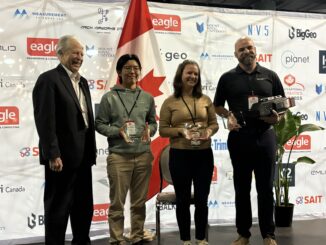I have a big confession to make: I have no idea what geomatics is. But I don’t feel so bad about that, because it seems like I’m not the only one.
A couple weeks ago, I was hired as the Marketing and Communications Officer for GoGeomatics Canada. I was really excited about my new position, but every time I told someone about it, I would get asked the same question: “What’s geomatics?”
Cue the sound of a record scratching as I stammered for a response until I finally settled on: “I don’t really know. Map stuff I guess.”
Let me give you a little background information on myself. I’m a writer and communications professional, not a geography expert. I’ve got a lot to learn.
But since working for GoGeomatics Canada, I’ve gained a huge understanding of the geomatics sector, thanks in part to the magazine that I help to manage. I even attended last month’s Ottawa social, which was a great way to get an inside understanding of the industry. Despite all that, I still don’t know how to explain geomatics to my family and friends. Part of the problem might have to do with the word “geomatics” itself. It’s vague, and even Microsoft Word doesn’t recognize it as a real word (I have a whole bunch of little red squiggly lines on my working document right now). But even the word “location”, which seems to be the proposed alternative, is intangible and might not be the solution that some hope for.
As an outsider looking in, it seems to me that the geomatics community has a problem with branding. To be fair, branding is a struggle for a lot of companies and organizations, and the dozens of sectors under the geomatics umbrella does not make it an easy task. But it’s a necessary one. Here’s why having a strong brand is important:
- Branding makes an organization instantly recognizable, with no explanation necessary
- It suggests a set of values and an image that is immediately understandable
- Ultimately, it convinces the audiences to align themselves with the brand’s image
You might be thinking, since everyone who is part of the geomatics industry understands what geomatics is, is rebranding even necessary? That depends. Of course, every industry uses a vocabulary that the general public doesn’t need to learn, and geomatics could fall under that category. On the other hand, industry growth could be stymied because of the simple fact that the general public does not know you exist.
As you know, there is a huge demand for surveyors right now. A rebranding campaign could go a long way to fill some of that demand. When I was in high school, a similar campaign was initiated to fill trades jobs. There were a number of television ads, and posters covered our school walls. Without having to ask, we all had a pretty good idea of what constituted a trades job, what kind of schooling would be required, what the expected salary would be, and whether it was a field we were interested in. The messaging was simple and effective. To be honest, I have a difficult time picturing a similar campaign for geomatics.
I don’t mean to be all doom and gloom about this. I see huge potential to take geomatics in exciting new directions, to fill that branding gap with something that will engage the public, and inspire them to take part in the geomatics community. Of course, all this begs the question: who will step up to rebrand geomatics? Perhaps the CGCRT will be in a position to address this question in the near future. Changes definitely won’t happen overnight, but in the meantime, I’m doing my best! And I’m always open to suggestions, so make sure to leave them below.




Be the first to comment